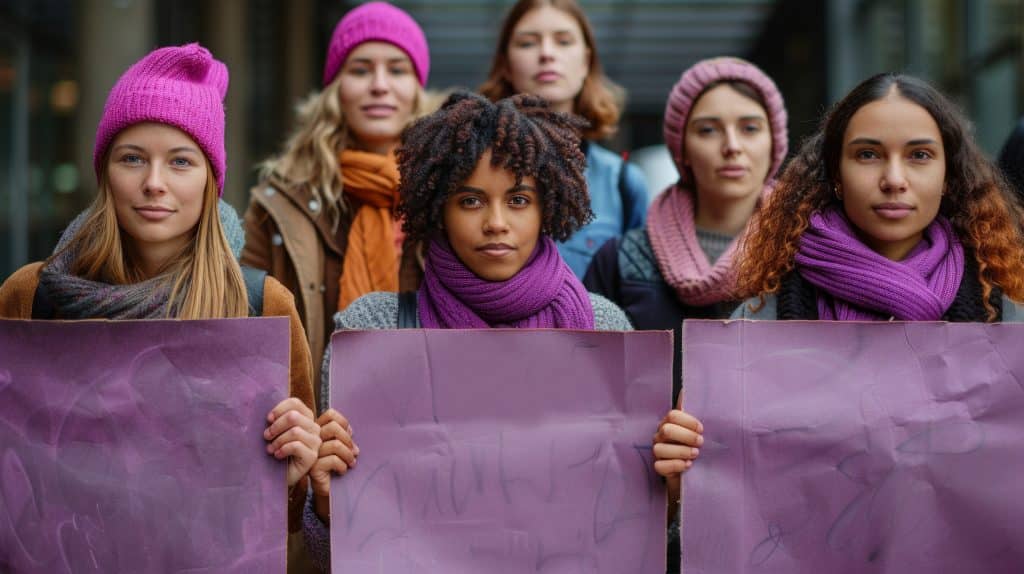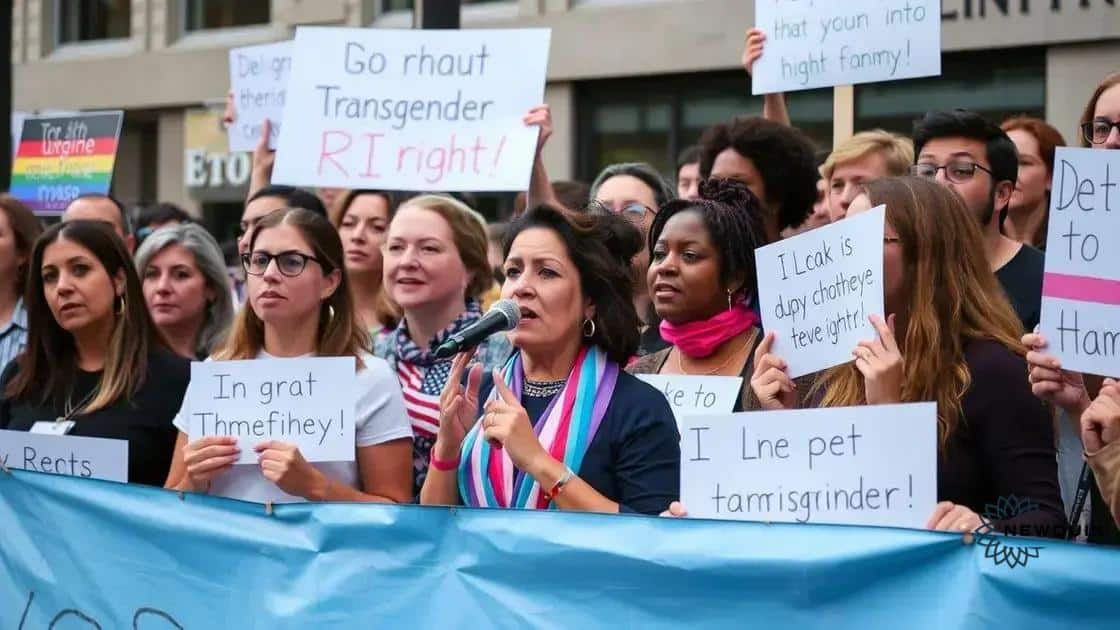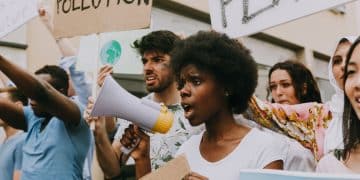Transgender rights protests: understanding the movement

Anúncios
Transgender rights protests aim to achieve equality by advocating for crucial issues such as healthcare access, legal protections, and safety from violence, while amplifying diverse voices through modern activism.
Transgender rights protests have emerged as powerful demonstrations for equality and acceptance. Have you noticed how these movements are shaping our society? In this article, we’ll dive into their significance, key issues, and the voices that resonate within this vital struggle.
The history of transgender rights protests
The history of transgender rights protests reveals decades of struggle, resilience, and hope. These protests are not just about fighting for visibility; they represent a quest for equality and acknowledgement.
Anúncios
Early Activism
The roots of transgender rights activism can be traced back to the early 20th century. Early activists fought against laws that criminalized same-sex relationships and gender non-conformity. Organizations began to form as spaces for the LGBTQ+ community to gather and support each other.
Stonewall Riots and Aftermath
The Stonewall Riots in 1969 marked a turning point in LGBTQ+ rights. Following this uprising, transgender individuals became more visible within the broader movement. Activists like Marsha P. Johnson and Sylvia Rivera led efforts to uplift the voices of those at the intersections of gender and race.
Key Milestones
- The formation of the first transgender rights groups in the 1970s.
- Activism in the 1980s focusing on the AIDS crisis.
- The push for transgender inclusion in civil rights legislation during the 1990s.
Throughout the late 20th century, the movement gained momentum as more individuals came out and defined their identities. Each protest added to the understanding and rights afforded to transgender people.
Anúncios
21st Century Developments
Entering the 21st century, transgender rights protests have become increasingly prominent. Events like the Transgender Day of Remembrance honor those lost to violence while raising awareness for ongoing issues. The Supreme Court decisions and social media campaigns have also played crucial roles in shaping public perception.
Modern protests are vibrant spaces filled with diverse voices from various backgrounds. Activists bring attention to issues like workplace discrimination, healthcare access, and violence against transgender individuals. These demonstrations are fueled by a strong sense of community and solidarity, reflecting a united front against injustice.
In summary, the history of transgender rights protests illustrates an ongoing battle for equality. It’s a story of individuals who have fought tirelessly for their rights and the rights of others, leaving a rich legacy that continues to inspire a new generation of activists.
Key issues driving the movement
Several key issues are driving the transgender rights movement today. These issues not only affect the daily lives of transgender individuals but also shape the landscape of activism worldwide.
Healthcare Access
Access to healthcare is one of the most pressing issues faced by the transgender community. Many struggle to find providers who understand their needs. This is crucial for both mental and physical health. Furthermore, insurance coverage for gender-affirming care remains inconsistent.
Legal Protections
Legal protections for transgender individuals are inconsistent in many areas. Some places have robust anti-discrimination laws, while others lack basic protections. This gap can lead to discrimination in housing, employment, and education.
Violence and Safety Concerns
Another critical issue is the alarming rate of violence against transgender individuals, especially transgender women of color. Protests often highlight the need for safety and justice. Advocates stress that every person deserves the right to live without fear.
- Increase awareness about violence against transgender people.
- Support organizations working toward legal changes.
- Foster community-based safety measures.
Beyond these issues, the movement advocates for representation in media and politics. Visibility in these spaces can help break stereotypes and foster understanding. Activists argue that when transgender voices are heard, society can begin to shift perceptions effectively.
Ultimately, these key issues all intersect. The progress made on one front can lead to advancements in another. As awareness continues to grow, so does the determination of advocates to fight for comprehensive rights and protections for the transgender community.
Voices from the front lines

Listening to the voices from the front lines of the transgender rights movement gives us insight into the lived experiences of many individuals fighting for justice. These voices play a crucial role in shaping the narrative and highlighting the challenges faced by the community.
Personal Stories
Many activists share their personal stories to emphasize the urgency of their cause. These narratives often include battles with discrimination, mental health struggles, and moments of acceptance. Their voices resonate with authenticity and empower others to share their experiences.
Community Leaders
Community leaders are instrumental in organizing protests and events. They use their platforms to amplify the issues affecting transgender individuals. By standing in solidarity with others, they build a stronger community focused on advocacy and support.
A Call for Allies
Transgender activists often call for allies to step up and support their efforts. Allies can help raise awareness and challenge harmful stereotypes. This collective support creates a more inclusive environment for everyone.
- Share stories to raise awareness.
- Organize community events and protests.
- Encourage others to become allies.
At protests, individuals often express their hopes and dreams for a more accepting society. These voices reflect a desire for change and the need for equitable treatment. Through sharing their experiences, they inspire others to join the movement and advocate for a better future.
The strength of the movement lies in its diverse voices. Each person contributes to the larger story of resilience and hope. By highlighting these experiences, activists create a powerful message that demands attention and action.
The role of social media
The role of social media in the transgender rights movement has been transformative. It serves as a platform for expression, education, and rapid mobilization. Activists now have the opportunity to share their stories and connect with a global audience.
Amplifying Voices
Social media allows transgender individuals to amplify their voices. They can share personal experiences and engage in discussions that foster understanding. This visibility helps break down stereotypes and promotes empathy.
Building Community
Online platforms create spaces where individuals can find community. Support groups and forums offer safe places for sharing experiences. These connections are vital for building a sense of belonging among transgender people.
Mobilizing Activism
Social media can quickly mobilize activism. When important issues arise, activists often use platforms like Twitter, Instagram, and Facebook to organize protests and campaigns. This speed is crucial in today’s fast-paced world.
- Sharing news and updates about legal changes.
- Creating hashtags to increase awareness.
- Gathering support for events and fundraising efforts.
Moreover, social media enables allies to join the conversation. Supporters can share posts that educate their followers about transgender issues. This solidarity strengthens the movement and promotes inclusivity.
Visual content is particularly powerful. Images, videos, and infographics can convey important messages quickly, making them more accessible to a wider audience. Many activists create engaging visuals to capture attention and convey their messages effectively.
As more people become involved in online activism, the impact of social media on the transgender rights movement continues to grow. This platform not only increases visibility but also fosters solidarity and encourages action.
Future of transgender activism
The future of transgender activism is poised for significant change as awareness and support continue to grow. With increased visibility, activists are more empowered than ever to advocate for rights and equality.
New Generation of Advocates
A new generation of young activists is stepping up, bringing fresh energy and ideas. They leverage social media to reach broad audiences and share their stories, connecting with others around the globe. This generation is not only passionate but also equipped with the tools to make real change.
Intersectionality in Focus
Future activism is increasingly recognizing intersectionality. By focusing on how different identities affect experiences, activists are demanding a holistic approach to rights. This means advocating for the rights of transgender individuals who also belong to marginalized racial, economic, or disabled communities.
Legislative Changes and Challenges
Legal rights are crucial for the transgender community. Activists are working tirelessly to push for laws that protect against discrimination. Meanwhile, some states are proposing harmful legislation that challenges progress. Staying vigilant and informed is vital for advocates to counteract these efforts.
- Advocating for inclusive healthcare policies.
- Promoting comprehensive anti-discrimination laws.
- Collaborating with other movements to amplify messages.
Community-based organizations are becoming essential allies in this activism. They provide resources, education, and support to individuals navigating the complexities of their identities.
Additionally, the rise of virtual activism during the pandemic has shown that advocacy can adapt to changing circumstances. Online events, webinars, and campaigns will likely remain popular, enabling broader participation.
As society continues to evolve, so does the approach to activism. The future will likely see more collaboration across various social justice movements, fostering a united front for equality.
FAQ – Frequently Asked Questions about Transgender Rights Activism
What is the main goal of transgender rights activism?
The primary goal of transgender rights activism is to achieve equality and ensure that transgender individuals enjoy the same rights and protections as everyone else.
How has social media impacted the transgender rights movement?
Social media has amplified voices, provided platforms for sharing stories, and mobilized activism quickly, allowing for widespread awareness and support.
What are some key issues currently faced by the transgender community?
Some critical issues include access to healthcare, legal protection against discrimination, safety from violence, and representation in media and politics.
Why is intersectionality important in transgender activism?
Intersectionality acknowledges that individuals with multiple marginalized identities may face unique challenges, allowing for a more inclusive approach to advocacy.





